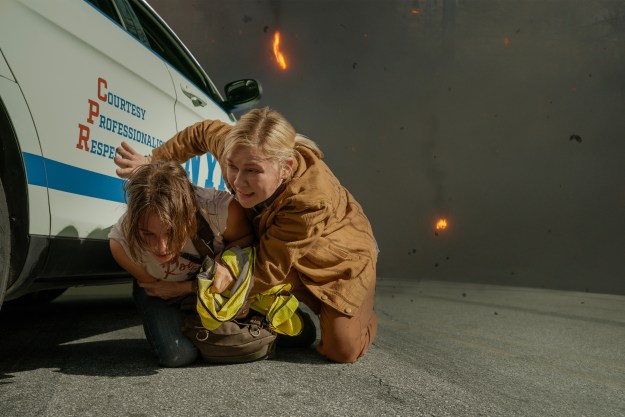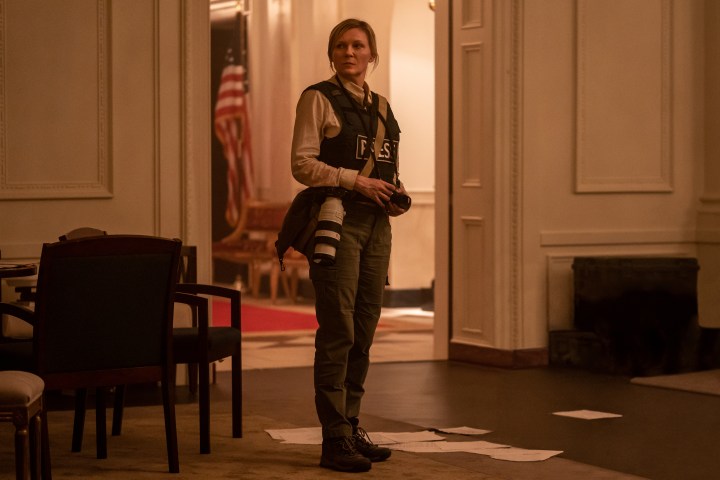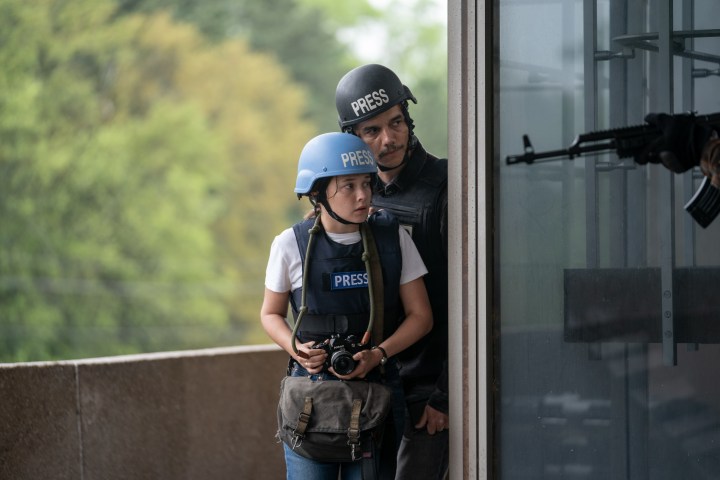
“Alex Garland's Civil War uses its breathtaking action sequences and jolting images of wartime violence to craft a disturbing portrait of a near-future America.”
- Shockingly powerful and intense action sequences
- Haunting lead performances
- A tight, 109-minute runtime
- Some on-the-nose dialogue throughout
A dystopian drama that thrills and disturbs, Civil War is a film of raw, immense power. Written and directed by Ex Machina filmmaker Alex Garland, it takes place in a near-future America that has been torn apart by two opposing military factions. It’s a shotgun blast of speculative fiction that, in other words, feels clearly inspired by — and rooted in — the very real political and moral divisions that are wreaking havoc throughout the U.S. today. For that reason, it’s unnervingly easy to meet Civil War on its own terms and make the same jump into its fictional reality that all great dystopian dramas demand.
Garland wisely and purposefully chooses not to crowd his film with the kind of extraneous details that might make the personal beliefs of its characters clear. The portrait he paints of America’s self-inflicted downfall is politically vague, which may come as a shock to some and make the film difficult to engage with for others. By making it impossible for viewers to know who they should root for or against, though, the filmmaker has made it so that the only things you can focus on are the many moments of horror and destruction that unfold throughout Civil War. The result is a lean, 109-minute action epic that is devastating and terrifying in equal measure, and which captures the seeming hopelessness of modern-day America in all of its suffocating might.

Civil War begins not with a text dump explaining the backstory of its dystopian future, but a close-up of an American president (Nick Offerman) as he stumblingly prepares to give a speech about the ongoing conflict between the U.S. military and the Western Forces. The latter, we’re informed, is a military coalition formed by California and Texas as a part of those states’ shared mission to secede from the rest of America. Offerman’s president puts on a tough face and promises that the WF is nearing defeat. We quickly learn that the opposite is true in what turns out to be just one of many instances in which Civil War pokes holes in America’s blustery brand of exceptionalism.
From there, the film picks up with Lee Smith (Kirsten Dunst), a veteran war photographer who has decided to travel with her Reuters colleague, Joel (Wagner Moura), to Washington, D.C. to interview Offerman’s commander-in-chief before he is likely captured and executed by the WF. Before they set out, they agree to take Sammy (Stephen McKinley Henderson), an older journalist who works for, as Joel puts it, “what’s left of the New York Times,” and Jessie (Cailee Spaeny), a young photojournalist who idolizes Lee, with them. Along the way, the four end up in several tense situations that shed more light on America’s fractured, primal state, add further fuel to Jessie’s passion for her job, and make Lee question even more her role in the wartime conflicts she’s photographed throughout her career.
These sequences, which effectively break up Civil War‘s central road trip into different chapters, are frightening and gripping in completely different ways. The New York City protest where Jessie and Lee first meet is, for instance, filmed in a handheld, cinéma vérité style that puts you in the very middle of a crowd of shouting, angry citizens and climaxes with a suicide bombing that is staged so intimately that you practically feel the concussive force of it in your seat. A second-act standoff between the film’s core journalists and a xenophobic soldier (played with chilling nonchalance by Jesse Plemons) is, conversely, shot with an unsettling stillness and escalates at such a patient, quiet pace that every gunshot that punctuates it is as impactful as any explosion. Never before in his career has Garland had a better grip on action filmmaking than he does here.

All of Civil War‘s set pieces, whether it be a clinically executed walkalong that arrives near the end of its first act or its climactic, D.C.-set invasion, are interrupted by the clicks of Jessie and Lee’s cameras and silent cuts to the images taken. These cutaways not only add a sense of visual variety to even the film’s most cacophonous shootouts, but they also establish a fascinating dichotomy within Civil War‘s action sequences. At every moment, Jessie and Lee are putting their bodies and lives on the line to capture images that, no matter how intense they may be, still evoke a sense of observational detachment. Furthermore, as they both strive to create the most artistic and evocative frames they can, questions inevitably arise about the very purpose of image-making, as well as how easily the thrill of successfully capturing even the most horrific of events can make one forget why they sought to do so in the first place.
The film’s head-on, clear-eyed approach to its subject matter gives Civil War a blunt-edged force that is both staggering and reinforces its unspoken ideas about how people choose to respond to violence. Some, like Jessie and Joel, charge headfirst into it with an enthusiasm that borders on recklessness. As the latter, Moura turns in a charismatic, charming performance that capably contains the darkness Garland’s script sometimes demands. Meanwhile, coming off her star-making work in last year’s Priscilla, Spaeny brings a naive, youthful energy to Jessie that makes her the perfect counter to the disillusioned Lee. Civil War balances the perspectives of each of its leads well, but the film ultimately belongs to Dunst, whose performance beautifully communicates the sorrow that exists beneath her character’s cut-and-dried, hard-line persona without relying on any weepy, maudlin shows of emotion.
Dunst’s face, with its impassiveness and steely gaze, proves to be the perfect visual anchor for Civil War, a film that presents the fall of America’s empire so straightforwardly that it doesn’t give you any chance to shrug or look away. Like so many of Garland’s films, it finds the right line between sci-fi surrealism and reality. Its near-future world is odd and yet easily recognizable, a cracked mirror that when held up in front of America’s ever-smiling face reveals a reflection that is jagged, stomach-churning, and, most upsetting of all, honest.
The movie is no gorier than many of the genre films that are made now, and its content isn’t particularly worse than what we’re all shown on the news every day. There is, nonetheless, something horrifying about Civil War and the indelicate way it presents its war-torn America. It’s an overwhelming, technically stunning action movie — one made all the more powerful by the fact that the events of its story feel both bizarre and potentially right around the corner.
Civil War is now playing in theaters.



